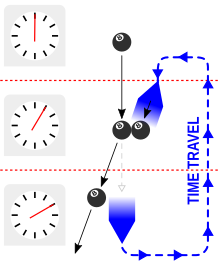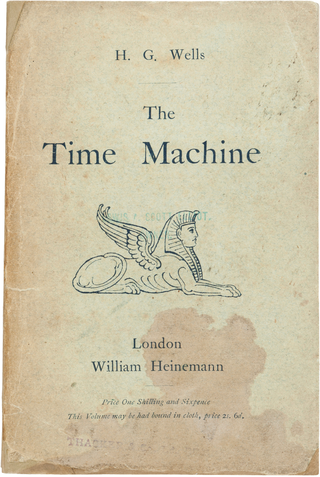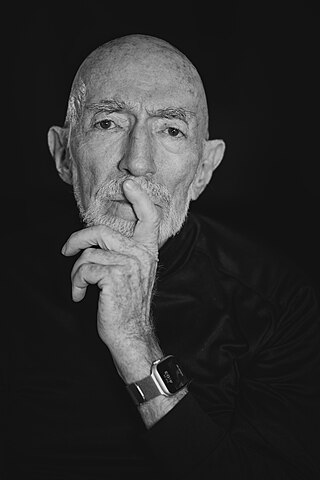Types
Temporal paradoxes fall into three broad groups: bootstrap paradoxes, consistency paradoxes, and Newcomb's paradox. [1] Bootstrap paradoxes violate causality by allowing future events to influence the past and cause themselves, or "bootstrapping", which derives from the idiom "pull oneself up by one's bootstraps." [2] [3] Consistency paradoxes, on the other hand, are those where future events influence the past to cause an apparent contradiction, exemplified by the grandfather paradox, where a person travels to the past to kill their grandfather. [4] Newcomb's paradox stems from the apparent contradictions that stem from the assumptions of both free will and foreknowledge of future events. All of these are sometimes referred to individually as "causal loops." The term "time loop" is sometimes referred to as a causal loop, [2] but although they appear similar, causal loops are unchanging and self-originating, whereas time loops are constantly resetting. [5]
Bootstrap paradox
A boot-strap paradox, also known as an information loop, an information paradox, [6] an ontological paradox, [7] or a "predestination paradox" is a paradox of time travel that occurs when any event, such as an action, information, an object, or a person, ultimately causes itself, as a consequence of either retrocausality or time travel. [8] [9] [10] [11]
Backward time travel would allow information, people, or objects whose histories seem to "come from nowhere". [8] Such causally looped events then exist in spacetime, but their origin cannot be determined. [8] [9] The notion of objects or information that are "self-existing" in this way is often viewed as paradoxical. [9] [6] [12] Everett gives the movie Somewhere in Time as an example involving an object with no origin: an old woman gives a watch to a playwright who later travels back in time and meets the same woman when she was young, and gives her the same watch that she will later give to him. [6] An example of information which "came from nowhere" is in the movie Star Trek IV: The Voyage Home , in which a 23rd-century engineer travels back in time, and gives the formula for transparent aluminum to the 20th-century engineer who supposedly invented it.
Predestination paradox
Smeenk uses the term "predestination paradox" to refer specifically to situations in which a time traveler goes back in time to try to prevent some event in the past. [7]
Grandfather paradox

The consistency paradox or grandfather paradox occurs when the past is changed in any way, thus creating a contradiction. A common example given is traveling to the past and intervening with the conception of one's ancestors (such as causing the death of the parent beforehand), thus affecting the conception of oneself. If the time traveler were not born, then it would not be possible for the traveler to undertake such an act in the first place. Therefore, the ancestor lives to offspring the time traveler's next-generation ancestor, and eventually the time traveler. There is thus no predicted outcome to this. [8] Consistency paradoxes occur whenever changing the past is possible. [9] A possible resolution is that a time traveller can do anything that did happen, but cannot do anything that did not happen. Doing something that did not happen results in a contradiction. [8] This is referred to as the Novikov self-consistency principle.
Variants
The grandfather paradox encompasses any change to the past, [13] and it is presented in many variations, including killing one's past self. [14] [15] Both the "retro-suicide paradox" and the "grandfather paradox" appeared in letters written into Amazing Stories in the 1920s. [16] Another variant of the grandfather paradox is the "Hitler paradox" or "Hitler's murder paradox", in which the protagonist travels back in time to murder Adolf Hitler before he can instigate World War II and the Holocaust. Rather than necessarily physically preventing time travel, the action removes any reason for the travel, along with any knowledge that the reason ever existed. [17]
Physicist John Garrison et al. give a variation of the paradox of an electronic circuit that sends a signal through a time machine to shut itself off, and receives the signal before it sends it. [18] [19]
Newcomb's paradox
Newcomb's paradox is a thought experiment showing an apparent contradiction between the expected utility principle and the strategic dominance principle. [20]
The thought experiment is often extended to explore causality and free will by allowing for "perfect predictors": if perfect predictors of the future exist, for example if time travel exists as a mechanism for making perfect predictions, then perfect predictions appear to contradict free will because decisions apparently made with free will are already known to the perfect predictor. [21] [22] Predestination does not necessarily involve a supernatural power, and could be the result of other "infallible foreknowledge" mechanisms. [23] Problems arising from infallibility and influencing the future are explored in Newcomb's paradox. [24]







